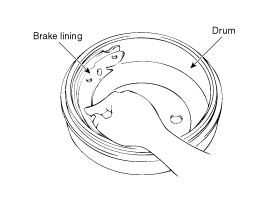 Hyundai Accent: Inspection
Hyundai Accent: Inspection
|
|
| 1. |
Raise the rear of the vehicle, and make sure it is securely supported.
|
| 2. |
Release the parking brake, and remove the rear brake drum.
|
| 3. |
Check the wheel cylinder (A) for leakage.
|
| 4. |
Check the brake linings (B) for cracking, glazing, wear, and contamination.
|
| 5. |
Measure the brake lining thickness (C).Measurement does not include
brake shoe thickness.
|
| 6. |
If the brake lining thickness is less than the service limit,
replace the brake shoes as a set.
|
| 7. |
Check the bearings in the hub unit for smooth operation. If it
requires servicing, replace it.
|
| 8. |
Measure the inside diameter of the brake drum with inside vernier
calipers.
|
| 9. |
If the inside diameter of the brake drum is more than the service
limit, replace the brake drum.
|
| 10. |
Check the brake drum for scoring, grooves, and cracks.
|
| 11. |
Inspect the brake lining and drum for proper contact.
|
| 12. |
Inspect the wheel cylinder outside for excessive wear and damage.
|
| 13. |
Inspect the backing plate for wear or damage.
|
 Installation
Installation
•
Do not spill brake fluid on the vehicle: it may damage
the paint; if brake fluid does conta ...
See also:
Replacement
1.
Remove the front wheel & tire.
Tightening torque :
88.3 ~ 107.9N.m(9.0 ~ 11.0kgf.m, 65.1 ~ 79.6lb-ft)
...
3. Exhaust emission control system
The Exhaust Emission Control System is a highly effective system which controls
exhaust emissions while maintaining good vehicle performance.
Vehicle modifications
This vehicle should not be mo ...
Room Lamp. Repair procedures
Inspection
Room Lamp
1.
Check that the switch operates properly after disconnecting the
room lamp connector (A).
...
Hyundai Accent Manuals
- Hyundai Accent 2017-2022 Service Manual
- Hyundai Accent 2010-2025 Owners Manual
- Hyundai Accent 2010-2025 Service Manual
© 2011-2025 Copyright www.hamanual.com




